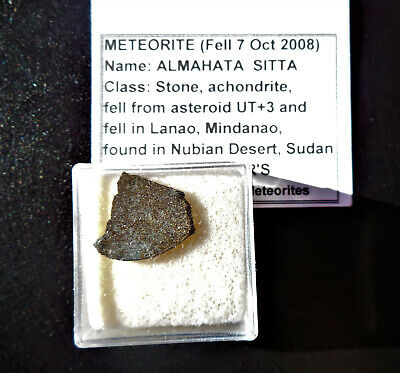-40%
0.632 gram - ALAMAHATA SITTA METEORITE - fell Oct 2008 in SUDAN- ex Schooler
$ 580.79
- Description
- Size Guide
Description
My name is Ruben Garcia aka MrMeteorite and I’m a meteorite dealer/collector. I have dealt in meteorites for 17 years and it’s been a wonderful ride.I’ve been featured in many books and magazines about meteorites, like Sky and Telescope, Discover, Iguana, Meteorite Times, and even the latest book by O. Richard and Dorothy Norton, called “What’s so Mysterious about Meteorites?”
I’ve also appeared in such TV shows as, Meteorite Men, Nova Science NOW, Cash and Treasures, and the United Stats of America with Hosts “The Sklar Brothers”. Of course, I’ve also been the subject of newspapers all across the country and various NPR and BBC radio shows.
I typically sell to high profile museums and universities all over the world. Everything I sell here is guaranteed just as if I were selling to a museum.
Payment is due upon auctions end, unless you contact me and want to wait a few days to bid on more items in order to combine shipping.
I include a business card sized label that describes each particular specimen!
Payment is due upon auction end.
Bid with confidence as all my auctions are guaranteed!
About this particular meteorite from the Meteoritical Bulletin
Almahata Sitta
Basic information
Name:
Almahata Sitta
This is an OFFICIAL meteorite name.
Abbreviation:
There is no official abbreviation for this meteorite.
Observed fall:
Yes
Year fell:
2008
Country:
Sudan
Mass:
3.95 kg
Classification
history:
(2009)
Ureilite, polymict, anomalous
Recommended:
This is 1 of 6 approved meteorites classified as Ureilite-an.
Comments:
Coords are near center of strewnfield
Approved 11 Apr 2009
Revised 19 Dec 2015: Corrected shock stage
Writeup
Writeup from
Almahata Sitta
20
°
43.04
'
N, 32
°
30.58
'
E
(“Station 6” in Arabic), Nahr an Nil, Nubian Desert, Sudan
Fall: 7 October 2008, 05:46 h local time (UT+3)
Achondrite (ureilite, polymict, anomalous)
History:
On October 6, 2008, a small asteroid called 2008 TC
3
was discovered by the automated Catalina Sky Survey 1.5 m telescope at Mount Lemmon, Tucson, Arizona, and found to be on a collision course with Earth. Numerous astronomical observatories followed the object until it entered the Earth’s umbra at Oct. 7.076 UTC the next day. The astrometric position of 295 observations of 2008 TC
3
over the period Oct. 6.278 to Oct. 7.063 was used to calculate the approach trajectory over the impact location in northern Sudan. The object exploded at a high ~37 km altitude over the Nubian Desert, and as a result the meteorites are spread over a large area. A search was organized by the University of Khartoum on Dec. 2–9, led by P. Jenniskens (SETI Institute) and M. H. Shaddad (
Khartoum
).
Physical characteristics
: During the first expedition, 15 meteorites were found along the approach path of the asteroid, for a total weight of 563 g. A second field expedition, on Dec. 25–30, added 37 meteorites, for a total recovered weight of 3.95 kg, spread over an area of 28 × 5 km. The meteorites are dark, thinly crusted, and roundish in shape, ranging in size from 1–10 cm.
Petrography
(M. Zolensky,
JSC
, and A. Steele,
CIW
): The sample is a fine-grained, fragmental breccia with subrounded mineral fragments and olivine aggregates embedded in a cataclastic matrix of ureilitic material. Mineral fragments include polycrystalline olivine, low-Ca pyroxene, pigeonite and carbon-rich aggregates up to 0.5 mm in maximum dimension, kamacite, and troilite. The examined samples have considerable porosity; the pore walls are commonly coated by anhedral to euhedral crystals of low-Ca pyroxene (Fs
2
Wo
3
) and olivine (Fa
12–14
), and in some instances spherules of kamacite and botryoidal masses of troilite. Most olivine and pyroxene aggregates have interstitial silicates with Si-content that increases adjacent to metal grains. Some clasts consist of rounded pyroxene grains containing an abundant nanophase Fe-rich mineral. Aggregates of carbonaceous material are common and measure up to 0.5 mm—these contain fine-grained troilite and kamacite, the latter containing Si and P. The major carbon phase is graphite. Shock effects are not apparent.
Mineral compositions and geochemistry:
Low–Ca pyroxene: Fs
2
Wo
5
-Fs
17
Wo
4
, Cr
2
O
3
= 0.33–1.02 wt%; pigeonite: Fs
15
Wo
5
-Fs
18
Wo
11
, Cr
2
O
3
= 0.72–1.11 wt%), olivine (Fa
8–15
, CaO = 0.15–0.51 wt%, Cr
2
O
3
= 0.03– 1.58 wt%). Kamacite is Fe
0.92
Ni
0.08
-Fe
0.96
Ni
0.04
. Troilite contains up to 4.3 wt% Cr. Mineral grains exhibit no zoning.
Classification:
Achondrite (ureilite, polymict, anomalous). Anomalous features include lack of zoning of olivine, large size of carbonaceous aggregates, and overall fine-grained texture.
Type specimens:
Samples with masses ranging from a few to a few hundred grams for a total of 3.95 kg are on deposit at
Khartoum.












